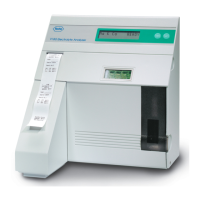Roche Diagnostics
Instructions for Use · Version 10.0 21
9180 Electrolyte Analyzer 1 Safety information
Safety precautions
Biohazardous materials
WARNING
Infectious samples
Contact with samples containing material of human origin may result in infection. All
materials and mechanical components associated with samples containing material of
human origin are potentially biohazardous.
r Follow standard laboratory practices, especially when working with biohazardous
material.
r Keep all covers closed while the system is operating.
r Always switch off the system or go to Standby mode, if possible, before you work with
an opened front cover (for example, for cleaning or maintenance).
r Wear appropriate personal protective equipment.
r If any biohazardous material is spilled, wipe it up immediately and apply a disinfectant.
r If sample or waste comes into contact with your skin, wash the affected area
immediately with soap and water and apply a disinfectant. Consult a physician.
CAUTION
Infectious waste
Contact with waste (liquid and/or solid) may result in infection. All materials and
mechanical components associated with the waste systems are potentially biohazardous.
r Wear appropriate personal protective equipment. Take extra care when working with
lab gloves. They can be easily pierced or cut, leading to infection.
r If any biohazardous material is spilled, wipe it up immediately and apply a disinfectant.
r If waste comes into contact with your skin, wash the affected area immediately with
soap and water and apply a disinfectant. Consult a physician.
WARNING
Sharp objects
Contact with probes or needles may result in infection.
r When you wipe probes or needles, use several layers of gauze and wipe from the top
down.
r Take care not to puncture yourself.
r Wear appropriate personal protective equipment. Take extra care when working with
lab gloves, which can easily be pierced or cut, leading to infection.
WARNING
Environmental harm
The system generates liquid and/or solid waste. This waste contains concentrated reaction
solutions and is potentially biohazardous. Improper disposal may contaminate the
environment.
r Treat this waste as infectious waste.
r Dispose of waste in accordance with the local regulations.

